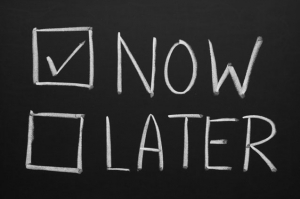“We show a preference for rewards that arrive sooner rather than later”
When we consider a choice between two options or rewards, we tend to prefer the readily available one. In other words: the current and near future are incredibly powerful. Dan Ariely explains the present focus bias as the ‘Adam and Eve problem’: “You can ask yourself how many of us would sacrifice eternity in the Garden of Eden, for an apple? Well it turns out we do it, and we do it all the time”.
So if we have to choose between an option right now, and a better option in the future, we tend to value the readily available option higher and undermine the long term. The sooner we can get an option, the higher we value it, and the more likely we’ll buy it.
Scientific research examples:
Imagine you have the next 3 days off and decide to watch a rented movie every night. What kind of movies will you rent? Will they be highbrow, or lowbrow? Highbrow movies typically offer less immediate pleasure (or even some pain), but provide long-term benefits in the form of educational or cultural enrichment. Lowbrow movies are more fun, but forgettable (such as a light comedy or action film).
Well, as Read et. al (1999) found, your choice for highbrow or lowbrow is influenced by when you decide which movies to rent. If you decide every evening, just before watching, you’ll end up watching more lowbrow movies. Whereas if you decide the first day which 3 movies to rent, you’ll rent relatively more highbrow movies…
There’s also more and more neurological evidence that our brain uses separate neural systems to value immediate and delayed rewards. McClure et. al (2004) found that parts of the limbic system are preferentially activated by decisions involving immediately available rewards. In contrast, regions of the lateral prefrontal cortex and posterior parietal cortex are engaged uniformly by intertemporal choices irrespective of delay.
Which of these two systems is relatively engaged the most, is directly associated with our final choice.
Online Persuasion tips:
[checklist]
- Make your solutions directly available (or at least as quickly as possible)
- Promote the availability of your offer (only when it is indeed readily available)
- Push products you prefer to sell by making them more quickly available, or promoting their direct availability relatively more
- Experiment with ‘future-discounts’ (promote a discounted price, which is only available when your customer is willing to wait)
[/checklist]
Further reading on the Present Focus Bias:
- O’Donoghue, Ted, and Matthew Rabin. 1999. “Doing It Now or Later.” American Economic Review, 89(1): 103-124.
- Ted O’Donoghue and Matthew Rabin, “Choice and Procrastination,” Quarterly Journal of Economics 116 (2001), 121-160.
- Read, Loewenstein & Kalyanaraman, Journal of Behavioral Decision Making; Dec (1999); 12, 4; pag 257; “Mixing virtue and vice: combining the immediacy effect and the diversification Heuristic”.
- McClure, Laibson, Loewenstein & Cohen, Science 306(15), (2004); “Separate Neural Systems Value Immediate and Delayed Monetary Rewards”.


